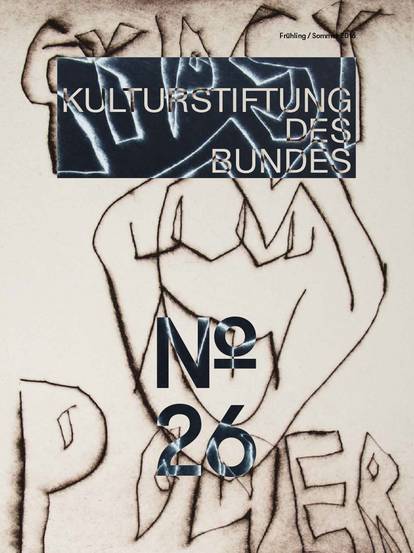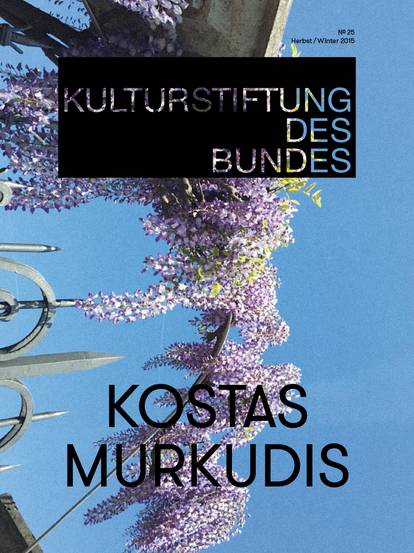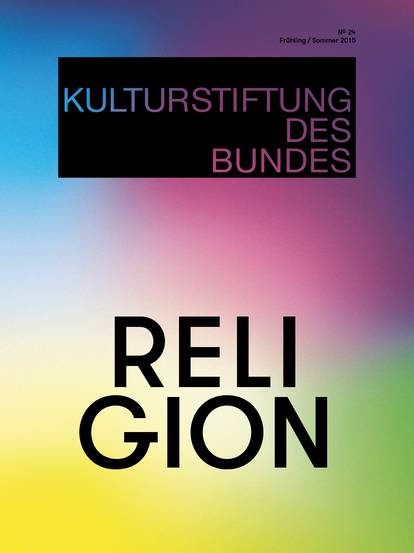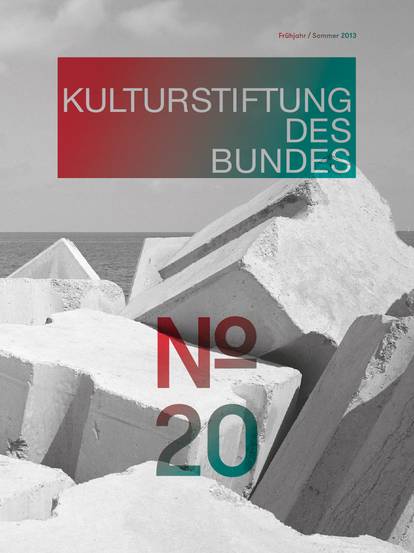Hans Ulrich Obrist: Ecstasy, transcendence and endurance are fascinating themes because, as I see it, they evoke an image of art being a portal you have to pass through. It’s an important topic for many younger artists, and you’ve been working on it for a long time. But before we get to that, let me ask you how it all began. How did you arrive at dance and choreography – was it a kind of epiphany?
Meg Stuart: I grew up in a theatre, and I think that certainly played a big role. Both my parents are theatre directors. Having the chance to see so many plays, watch dancers and actors up close, made an impression on me. But somehow, I didn’t want to act, to play a character, I simply wanted to be myself. I didn’t know what this “self” was, or whether there were multiple “selves”, but there was always that wish. First, I got into sports, like running track; the physical aspect was important. Then I started getting more involved in dance, and at some point, I let the running go. Then I took a dance class in high school which was not about learning to imitate other people’s movements – though I did that, too – but rather choreography. I did dancer studies – standing, sitting, lying – looking carefully at each part of the body, breaking it down piece by piece. That’s when I started coming up with dances without really knowing how to dance. I didn’t have a technique that I’d eventually have to discard later on. First, I had to build a structure and technique around me in order to realise the things I imagined. When I was young, I tried out alternative techniques, but I also studied the “modern masters” – Cunningham, Graham, Limón. I don’t know if you can call that an epiphany, but that’s how I started.
Obrist: You originally come from New Orleans …
Stuart: Yes, I am from New Orleans but my first breakthrough as an artist happened at the Klapstuk festival in Belgium when I was 26 with the work Disfigure Study. Up until then I had been working years on various short studies in New York and these explorations came together in Disfigure Study (1991). It was this first evening piece that launched me into the scene in Europe.
Obrist: I asked about New Orleans because I recently spoke with the singer and musician Solange [Knowles] and the director Alan Ferguson, both of whom live in New Orleans. They told me that New Orleans is so spiritual that it radiates something transcendental and the people there relate to one another in a very special way.
Stuart: I was quite young when I left New Orleans. I can remember the hurricanes and Mardi Gras, but not much more than that. When my mother started working at CalArts, [California Institute of the Arts, Los Angeles], I would wander the halls of the institute, watch Ravi Shankar play [editor’s note: Ravi Shankar, Indian musician and composer, appointed professor of Indian Music at CalArts in 1970], see the art exhibitions held at CalArts in the seventies and the dance performances there. All these different art practices in one space – I’m sure it influenced me. My parents often took me to classical concerts. Whenever I closed my eyes and listened to the music, I’d imagine people dancing and moving. I created my own little world, a space where I could control things.
Obrist: It seems you really found your own “language” in Belgium. One of your first pieces that came to my attention was No Longer Readymade (1993) – a piece that deeply resonated with the art world. Can you tell us something about what went into No Longer Readymade?
Stuart: It was my second piece, and maybe it was born out of crisis. Creating a second work while on tour with the first, getting a lot of attention very fast, being pulled out of New York and diving into the European festival scene – that was a lot to handle at one time. The centrepiece of this work is a solo. I’m digging through the trash in my pockets, pulling out receipts, coins and whatnot, spilling the detritus of life onto the floor. Then I take off my clothes, a men’s suit, a women’s suit and my dress ... and I hang them from my arms on two hangers and then start walking on my face with my Doc Martens. And that’s when I asked myself, is this enough for you? What do you expect from this? My previous piece Disfigure Study was like a long research project on distortion and fragmenting the body and playing with physicality and light. But this was an entirely new approach to the question “Here I am, what now?” It was the first time I studied physical and emotional states. The piece opens with a dancer, Benoît Lachambre, shaking his head violently for about four and a half minutes and then gesturing feverishly. Then he starts shaking and does the whole thing in reverse. He’s completely out of control, he’s blurring like in a Bruce-Nauman-video. He’s pushing himself to the limit yet continues articulating in this frenzy. When we started rehearsing the piece, he vomited in the studio. Only after several rehearsals was he able to perform it. It was the first time I was interested in fever and sweat – could this be a “language”? How do we use these kinds of involuntary physical responses as dance material? It was then that I integrated physical and emotional states into the choreography.
Obrist: This piece seems to go beyond the rational; there are irrational forces that come into play. Andrei Tarkowski once said that we need to re-introduce rituals because they have disappeared from the modern world. It’s interesting that ecstasy is regarded as something positive in indigenous cultures and in ritualistic contexts. But in capitalism and in our globalised world, it’s somehow taken on a negative connotation. In your work it clearly has a positive connotation. I was wondering about when the subject of ecstasy entered your work. When you started, it must have been quite unusual, right?
Stuart: From a Western perspective, I think rituals are things we do out of habit, if not by choice. But we’re constantly occupied with such rituals. We create them for ourselves, we’re forced to participate in those of others, rituals are all around us. So, it’s about acknowledging them, and also reinventing them. Rituals are a series of intention-driven actions, just like with magic. Your actions have a certain intention, and you expect a certain outcome. Going to the theatre is a ritual as well. I don’t know how I came to introduce that. I think I’m receptive to energies or streams of energy that are not only my own. We know that everything is influencing our nervous system and our electromagnetic field. Every day we’re influenced by what we see, our consciousness is inundated with information. The question is, how do we deal with it, how do we purge ourselves of it, what thoughts are our own and which are not, and how do we work with these forces?
Obrist: You talked about rituals, but I’m curious about the notion of ecstasy. To a certain degree, improvisation is present in all your works. As you mentioned about your second piece, No Longer Readymade, improvisation was a gateway to all these different states and sometimes ecstatic states ...
Stuart: Exactly …
Obrist: Then let’s talk about improvisation and ecstasy.
Stuart: One inspiration for my last piece Celestial Sorrow (2018) was the very repetitive music of a Jathilan ritual I saw in Indonesia. It was a remarkable performance on the outskirts of Yogyakarta. The dancers performed very simple, 20-minute ritualised movements with their arms. Suddenly they seemed possessed and fell into a trance ... and it wasn’t clear if it was real or not, or self-induced. Some things happened in front of you, and other things backstage. The dancers would take off their costumes and come back in something more pedestrian. There was such absolute chaos that no one knew what was part of the performance and what wasn’t. Was it all just preparation for that moment of release, the freeing of these dark energies? I found it all very contemporary and very complex. So we started crafting our own version together with two musicians. The dancers also go through a kind of trance. I think we all want to escape the reality of our daily lives. We all want to feel that we merge with something else, that we overcome the borders between us and the others. We can take drugs or get high on music and repetition, or lock ourselves in a room and concentrate on our own breathing... I think we all have that wish to work on higher realms, to have a more singular focus, to be less absent-minded and distracted.
Obrist: When I was London I saw your piece Until Our Hearts Stop (2015), which I thought was very impressive. It also had to do with this very different state. As in your earlier pieces, you often focus on the notion of exhaustion and how exhaustion can lead to a transcendental state ...
Stuart: ... or to a nervous breakdown (laughs). Actually, I think we sometimes like being exhausted. I think exhaustion gives us the feeling of being in the here and now, it’s our neoliberal mode, this idea that we’re always working. It’s also about working through the exhaustion in order to achieve a higher state of consciousness where more subtle frequencies resonate. Exhaustion is either a wish or a problem, but it can also be a strategy – a strategy of art-making. You tell someone: look at this, now look at it again, and again ... no, this image is not finished yet. This intensity, this obsession, to over-stretch time, to force people to be hyper-present – that’s what I see as the responsibility of art right now. Insisting on being accountable for where we are.
Obrist: Improvisation was a theme we both explored in Laboratorium – our first collaboration in 1999. It’s a work that is seldom discussed anymore. I’d be interested in hearing your recollection of it.
Stuart: Laboratorium was an incredibly imprecise study that examined the relationship of performance and research, science and research, and art and research. It was the basis for an improvisation, the last piece of a longer project titled Crash Landing, which I put on in Moscow in 1999. We were lots of artists, many of whom were Russians, and the space we chose was way too small for all of us – it was rather uncomfortable. The work was about the future, about the body of the future, and how we see ourselves in the future. Each performer could suggest things. There was nobody saying, “but this is my project”. We were not concerned with individual authorship, but rather a collective working method where everything was mixed, alliances were formed and questions were jointly investigated ... Looking back, I can see it as quite radical in its haphazard methodology of insisting on collaborative encounter through improvisational performance, considering the invitation and the context.
Obrist: It was also about demarcation – between the stage and the world, if you will... It wasn’t very clear where the stage began and where it stopped, of even if there was a stage ... The young Tino Sehgal was also there as a student – that was when he was still dancing and working with Xavier [editor’s note: French choreographer Xavier Le Roy]. I told him that I’d be doing an interview with you and he sent me a question to ask you this morning: Where do you see a demarcation between dance which is meant to be performed, and ritualistic practices like those of the shamans or Shakers which occur off stage?
Stuart: Dance that is meant to be performed is about a set of principles or proposals that is shared with an audience. Shamanistic practice and rituals are grounded on service and intention. Shamans with spirit guides dive into other worlds to heal members of society. This is a service for the community. People go clubbing every weekend, an improvised dance ritual, in search of connection and release and ecstatic shared moments. It is clear that the codes of behaviour are very narrow even in places like Berghain and I can imagine there will be more and more hybrid undefined open spaces in the future for sharing, voicing, releasing and dancing as strategies of survival and healing.
I am hoping that the Tanzkongress in Dresden can be such a lively, unconventional space for collective action and shared intention. We are going to create a five-day gathering, somehow intricately and magically composed, that functions as a social choreography for meeting, exchange, conflict and transformation. A rave deconstructed and other variations of social dancing and encounter are essential to this meeting concept. The rave format in the Tanzkongress would commence early in the morning in that massive hall of Hellerau. A charged political space in the daytime with the removal of the trope of nightlife. It would be a space where people could express themselves freely thanks to a different kind of receptivity. So, in this huge cavern of space, I want to create something fluid that shifts the pace so that eventually the music slows down, breaks down and another space of listening and presence emerges.
Obrist: Cedric Price and Joan Littlewood, who came up with the Fun Palace in the 1960s, also described this idea of having moments of noise and silence. Suddenly the rave would fall silent – a rupture from fast to slow. So I love your idea. In 2002, Hortensia Völckers got me involved while they were mapping the future of the Federal Cultural Foundation. It was a utopian undertaking which she worked to make come true. And to this day, the Foundation still possesses this utopian vein. The Tanzkongress is also a kind of utopian undertaking. There weren’t many congresses of this scope and magnitude – in the Weimar Republic in 1927, 1928 and 1930. What kind of rituals are you planning for the Tanzkongress?
Stuart: I’m quite interested in the Monte Verità gathering in Switzerland in 1917 where spiritualists, anarchists and artists came together on the mountain to discuss and share alternative ways of living. In the first Tanzkongress (1927) the dance artists were passionately arguing and looking for definitions that would be unthinkable nowadays like what is dance, what a dancer should be, what is the purpose of dance now? They also describe a legendary party where the whole congress came together at the end. I would have loved to witness that. I’m very interested in the social dimension of dance, dance history, sacred dances, contemplative scores and visualizations, martial arts. What’s important to me is that dance isn’t merely the warm-up for the discourse part, but that both are integrated into the same format. As a curator, what advice would you give me?
Obrist: In 2005 when I was working on the “Theater der Welt” festival in Stuttgart, I had initially planned to do an interview project for the stage, a kind of marathon. In the beginning, it was just me interviewing people for 24 hours, but that got lonely after a while, so I invited Rem Koolhaas to join me. Little by little, it became more of a hybrid format with performances, talks, etc. The interesting thing about your idea, of course, is that people would come to listen to a neuroscientist talk and then see a contemporary artist. Or they come to see the artist but would also hear what an architect had to say. This can help break down professional ghettos and avoid having only dance professionals attend. Right now I’m exploring the phenomenon of dance manias, also known as choreomania or St. Vitus’s Dance which occurred in Europe in the 14th and 15th century. It was a social phenomenon when ordinary people in cities – not professional dancers – would dance and dance until they collapsed from exhaustion. There was an outbreak in 1374 in Aachen. Wouldn’t it be amazing if a dancing mania broke out in Dresden?
Stuart: … Or debate mania! When I shift into different states of consciousness very quickly or turn my attention from the moment, I feel I’m bending the laws of time and space, I’m moving through dimensions. I feel there’s a solid truth you can arrive at through physical practice. Dancers know this, but it needs to be acknowledged in other areas – how certain movements can impact our consciousness. In Hellerau, there’s this big garden in the back, and I hope we can use it to create some common rituals, cook together, engage in other forms of exchange.
Obrist: Well, it appeals to all the senses. Margaret Mead once said that we need rituals that appeal to all the senses. I recently read a text by Dorothea von Hantelmann where she asked: What form of ritual corresponds to the life, the social structure of the early 21st century? How collective, how individualised, how rigid, how open, how liberal should such a structure be? That seems to have some relevance for Dresden.
Stuart: There will definitely be various forms of coming together and celebrating, but also coming together and mourning. Dresden won’t be a five-day party. The congress has a dramaturgy that covers a wide range of aspects and provides space for meditation and movement, but also discussions about non-violent communication, or social justice or the power of intention.
Obrist: There’s so much violence and xenophobia in Dresden right now. It has made me think of your work Alibi (2001) which explores themes of fanaticism and violence. In an interview you described how shocked you were, moving from New York to Brussels and suddenly being in a place where people don’t speak English as their native language. What’s especially interesting is that the Dance Congress has the potential to connect with the population. Brecht talked about creating an “epic” theatre for the masses. Perhaps one could extend Brecht’s theories to dance and see whether it could change the city. Maybe you could change Dresden.
Stuart: Maybe. I just heard about this German-Syrian artist Manaf Halbouni who erected three buses in front of the Dresden Frauenkirche. I would very much like to have a dialogue with the Dresden scene. I’ll also be teaching a workshop at the Palucca University of Dance and the Academy of Fine Arts in Dresden (HfBK).
Obrist: Would you say your works are political?
Stuart: When you’re working with policymakers to put on the Tanzkongress, it’s a very different type of collaboration, and a different type of visibility. I often talk about ethics and responsibility. Violet (2011) is a completely abstract piece that explores energetic patterns in nature. It features five dancers with five platonic bodies. It was made at the time of the Arab Spring and the tsunami in Japan, and I asked myself: What causes change? At what moment is there a radical shift in thinking and how do we handle it? Frankly it was a response to exhaustion: I don’t have enough energy for this ... Normally you have all the time in the world for abstraction, it is something cold and detached. You work with lines, forces, geometries, but here we were working with abstract movements under stress in a charged heated atmosphere. There was an urgency and a call. That is why it felt extremely political. For many years and in different contexts I have created and held space for artists, musicians and dancers to exchange and meet. In Sketches/Notebook (2013) the dancers were on equal ground with the visual artists and musician. Questions and ideas were exchanged through shared actions and simply by sharing a working space together. I aim to create a dynamic working space of encounter for the extended dance community at the Tanzkongress.
Obrist: Sketches/Notebook leads me to my last question. I started a project on Instagram which has to do with sketches and notebooks. Personally, I find it appalling that handwriting and doodling is disappearing. So I decided to ask every artist at the end of an interview to write or sketch something that I can post on Instagram – a sentence, motto, a quote. So now, if you wouldn’t mind, I’d like to ask you for a doodle …

![[Translate to English:] Magazine 38](/fileadmin/_processed_/f/1/csm_Magazin38_Cover-Vorschau_921x1230_689f428dc3.jpg)
![[Translate to English:] Magazine 37](/fileadmin/_processed_/b/c/csm_Mag37_Cover-Vorschau_921x1230_b5129fdb2a.jpg)
![[Translate to English:] Magazine 36](/fileadmin/_processed_/2/a/csm_Cover_Magazin36__issuu_2f3cef97bb.jpg)





![[Translate to English:] Magazine 30](/fileadmin/_processed_/c/b/csm_magazin30_vorschau_9005f773d3.jpg)














